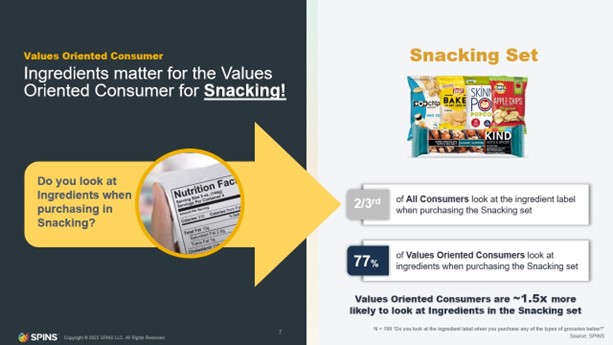Key Takeaways:
- Consumers are becoming more health and values-oriented, and are willing to pay a premium for products that align with their values.
- Functional ingredients, which provide a specific health or nutritional benefit, are increasingly popular among consumers.
- Snacking is one category that has seen a lot of innovation in the functional ingredients space.
- Values-oriented consumers are 1.5 times more likely to look at ingredients in the snacking set than the average consumer.
In today’s fast-paced world, consumers are becoming more conscious about their health and well-being. This has led to the rise of values-oriented consumers, who are willing to pay a premium for products that align with their values. In this article, we’ll be discussing how functional ingredients are shaping the industry and how brands and retailers can innovate to cater to this segment of consumers.
The Evolution of the Values-Oriented Consumer:
The rise of the values-oriented consumer has led to the evolution of the natural and organic industry. Consumers are now looking for products that are better for them, the environment, and animals. This has led to the rise of functional ingredients, which are ingredients that provide a specific health or nutritional benefit. Functional ingredients have become increasingly popular, and consumers are willing to pay a premium for products that contain them.

Two-thirds of all consumers look at the ingredient label when purchasing from the snacking set
Snacking is one category that has seen a lot of innovation in the functional ingredients space. Values-oriented consumers are 1.5 times more likely to look at ingredients in the snacking set than the average consumer.
Functional Ingredients in Snacks:
Taking a look at top line sales, the Snacks category has seen an increase in sales but a decrease in units sold across all channels. This means that a lot of the dollar sales growth can be attributed to an increase in price, which is in line with all the inflation news lately.
As consumer spending pulls back, consumers are putting more thought into what they are purchasing. Consumers are looking for intentional snacks that provide functional benefits and indulgence at the same time.

The use of chia seed/oil is up 1159% in chips, pretzels, & snacks
Functional ingredients like Chia Seed or Oil, Whey, and Coconut Oil are seeing triple-digit growth in sales and units in the Chips, Pretzels, and Snacks categories. Meanwhile in the Cookies & Snack Bars category, Whey, Grain-based, and Goji Berries are seeing strong growth. With Whey seeing a +566% and +802% growth in year-over-year sales in Chips Pretzels & Snacks and Cookies & Snack Bars respectively, it seems like high protein snacks are popular with consumers.
The Importance of Sustainability:
Sustainability is becoming increasingly important to consumers, and brands are responding by introducing certifications such as Upcycled.

Certified Upcycled products saw a +35.5% increase in year-over-year sales and +28.4% increase in units sold. Consumers are interested in reducing food waste, and the Upcycled certification is a great way to showcase that your brand is doing its part to reduce waste.
Though consumers have pulled back on spending, typically they still choose to spend their dollars on products that confer some benefit or one that resonates with their lifestyle. Functional ingredients are shaping the industry, and values-oriented consumers are driving the demand for these ingredients. Brands and retailers that can innovate and cater to this segment of consumers are well-positioned for success. As consumers continue to prioritize their health and well-being, functional ingredients will continue to play a vital role in the food and beverage industry.
How can Brands use this data?
CPG brands can use information like this and other data from SPINS to stay ahead of the curve and meet evolving consumer demands for functional and sustainable snacks such as:
- Incorporating functional ingredients in their products. By doing so, they can tap into the growing demand.
- Differentiating their products to appeal to consumers who are looking for innovative ways to add to or change their diets.
- Explore new categories. By incorporating functional ingredients they can offer new and innovative products to add to a retailers mix.
- Leveraging SPINS data. Insights like these help brands identify growth opportunities, track category performance, and optimize product offerings.
How can Retailers use this data?
Retailers can use the information to make informed decisions about their product offerings, marketing strategies, and category management. Here are a few ways they can use this information:
- Identify growth opportunities. Retailers can use SPINS data to identify growth opportunities in the hemp seed market and adjust their product offerings accordingly. By stocking popular snack products and exploring new product categories, retailers can tap into the growing demand for functional and sustainable products.
- Cater to consumer preferences. Retailers can use the information to cater to consumer preferences by offering a variety of products that meet different needs and tastes.
- Highlight sustainability. By doing so, they can differentiate themselves from competitors and appeal to consumers who prioritize sustainability.
- Optimize category management. By tracking category performance, identifying trends, and adjusting their product offerings they can stay ahead of the curve and meet evolving consumer demands for functional and sustainable products.







